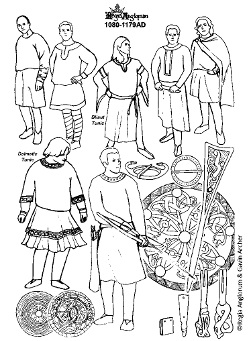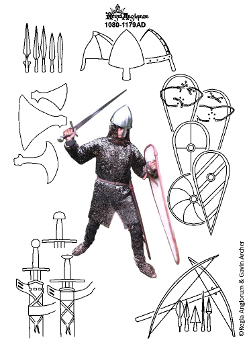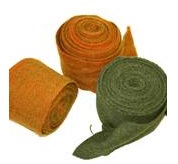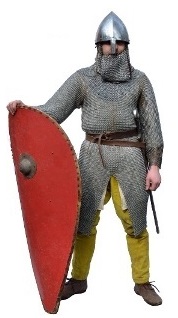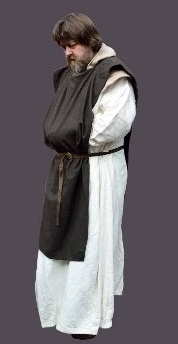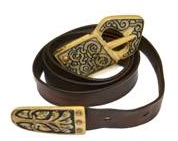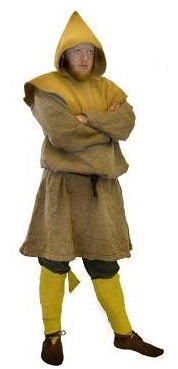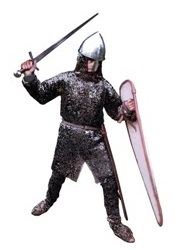Authenticity Officer’s Photo Guide – Examples of Authentic Kit
The Examples of Authentic Kit is a gallery of good examples of authentic kit, and can be used by members as a guide for what to aspire to. However, it is also an open competition amongst the membership, where they can submit photographs of themselves in kit – with examples of the most authentic kit being shown here.
All Periods
All Periods793 - 899
793 - 899900 - 979
900 - 979980 - 1041
980 - 10411042 - 1079
1042 - 10791080 - 1179
1080 - 11791180 - 1215
1180 - 1215Norman England and the Crusades. The Anarchy.
During this period Norman England is dominated by European fashion. As Christians, all women cover their hair when outside the home. In England the long scarf veil is worn just as it is across Europe. It is worn loosely draped over the head and wrapped around the shoulders whilst leaving the neck showing. The hood like wimple is still worn, but is becoming less fashionable.
Most women wear a linen shift. There are a number of different garments that can be worn over this. Most common is an ankle length woollen dress with either sleeves that are loose and cut slightly shorter to expose the cuff of the shift underneath or else with tight sleeves to the wrist. Neck-holes are either round or oval, and can have a keyhole opening. Decoration, in the form of facings, silk strips, embroidery or tablet weave, can be applied to the cuffs. Tied belts of simple braid or cloth can be worn, but never belts of leather.
Sometimes a ‘mantle’ can be worn, which is a woollen conical over garment that can be worn belted with a wide cloth sash. Loose sleeved dresses and mantles are never worn together.
Another option popular with rich women is the European fashion of wearing dresses with extremely wide cuffs known as bliaut sleeves. Some of these bliaut dresses are more fitted with sewn in gathering patches being added to their sides.
Shoes are of the simple, two-part turn shoe construction and are usually low, coming to below the ankle.
Jewellery in the form of delicate decorative openwork brooches of Urnes beasts and silver penny brooches are popular. As the 12th century progresses the ring like annular brooch replaces the traditional disc brooch as the main form of fastening brooch.
The primary garment is the tunic. Its skirt comes to the knee cap or just above and it’s always worn tight to the forearm and wrist. Neck-holes are either round or oval and often have a keyhole opening. Decoration, in the form of facings, embroidery, silk strips or tablet weave, can be applied to the cuffs, neck-hole and around the hem of the skirt. Tunics are usually made from wool but can also be from linen.
European styles of tunic are popular. These include tunics with a wide neck-hole facing and applied facing to the hem of the tunic’s skirt. The Norman style of split front and rear shirt is also common.
Belts can be made from either braided wool or from a leather strap. They can be simply tied or else closed by a buckle of bone, iron or copper-alloy. Belts sometimes have strap-ends attached.
For warmth a cloak can be worn, clasped on the right-hand shoulder by ties or a large disc brooch, pin or annular brooch.
Leg coverings, if worn at all, should be tight to the leg and are usually hose and braies or more rarely trousers. Leg wraps can also be worn. These are long strips of 10cm wide woollen cloth worn wound about the lower leg from the ankle to the knee.
Shoes or low boots are of the simple, two-part turn shoe construction. Most are low, coming to the ankle or below. Some boots are slightly higher, coming up to the mid-calf, although not popular at the start of the period they do become more numerous as the 12th century progresses.
Jewellery is usually of copper-alloy or pewter although some silver is still used. Romance and Urnes styles are common. As the 12th century progresses the ring like annular brooch replaces the traditional disc brooch as the main form of fastening brooch.
Weapons and armour are generally plain and utilitarian being mass produced. The first crusade at the end of the 11th century leads to a number of military improvements.
The conical iron helmet is worn by all warriors. The kite shield is the dominant shield shape although the traditional round shield continue to be used by some. Mail shirts are worn by most warriors. Generally they come down to the knees, and are split front and back. The sleeves end either at the elbow or at the wrist. Mail shirts also have an integral hood and some warriors in addition wear mail leg protection.
Warriors carry into battle 1 or 2 javelins to throw and a spear to use one-handed and overarm in combat. Additionally a sword is generally carried by most warriors. Dane Axes are carried by some, a large axe wielded in both hands and deployed to stop mounted warriors.
Mounted cavalry is the norm for professional warriors. Archery is used in combat both by long bows and crossbows. Most arrows are bodkins, designed to pierce mail-shirts.
Many men wear leg bindings wrapped around their lower legs. They average 9cm wide, have a natural selvage and are primarily woven in a twill to give them more stretch.
By Liz DabornThis Lord wears a full hulberk mail shirt along with a single-piece conical helmet and a kite shield. The sleeves of his mail shirt extend to the wrist for added protection.
GregIn outdoor/work clothes - in England from 1128 onwards, Wales 1131, Scotland 1136, Ireland 1145. Cistercian monks are distinguished by their white habit and hood, and dark scapular.
MartinA leather belt with a bone buckle and bone strap end with Romance style floral decoration.
by Roland WilliamsonA free man dressed in an undyed tunic. His hood and leg bindings are however more colourful having been dyed with weld.
Malcolm
